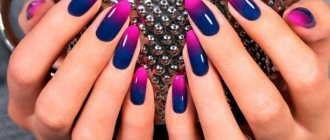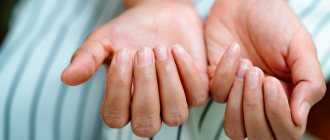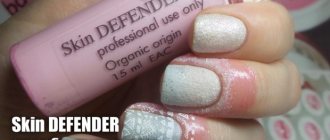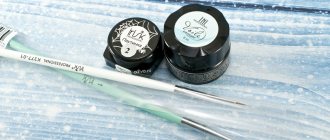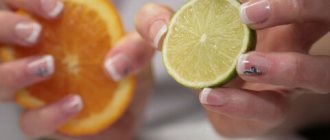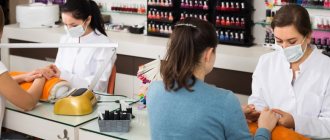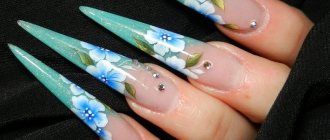Many people experience various diseases of the nail plates on their hands and feet. So, some are bothered by ingrown toenails, some are bothered by deformation of the horny plates, and others are bothered by fungal nail diseases. In all cases, patients' lives are complicated by a visible cosmetic defect, which forces them to give up open shoes or forces them to hide their hands. Many of these people decide to see a doctor for qualified help, but they have a question about which doctor treats their nails. When choosing a specialist, much depends on the specific nail problem.
Who is a podiatrist?
A specialist with a medical education who specializes in pathologies of the foot and nail plate is a podiatrist. The doctor works at the intersection of two areas, surgery and dermatology. The doctor must simultaneously be able to cope with problems of the skin and nail plate using conservative methods, as well as provide prompt assistance - for example, if a patient comes to him with an ingrown nail, etc.
Cleo Line employs qualified specialists with many years of experience who are constantly expanding their knowledge and skills. Podologists at our center use modern diagnostic and treatment methods, which allows us to cope with any problem as effectively as possible in a short time.
How it treats
A visit to mycologists and dermatologists usually begins with a visual examination and questioning of the patient. The specialist will ask what exactly is bothering the patient and for how long, what it might be connected with in his opinion. You also need to remember whether your relatives have ever had similar problems and you will have to talk about your lifestyle, places of work and recreation. It is best to immediately prepare and try to give yourself answers to all the questions described above; truthful answers will help the doctor quickly establish a diagnosis and recommend treatment. To determine the presence of infection, the doctor makes a scraping and takes several scales for analysis - this procedure is painless. If, in the doctor’s opinion, problems with the plates are associated with other pathologies, for example, with thyroid disorders, then the patient will definitely be sent to an endocrinologist. You may also need to consult a therapist, surgeon and other specialized specialists as necessary. For pathologies of the nail plate, dermatologists prescribe the following treatment:
- Local agents to soften or strengthen the nail plate, or antifungal ointments, nail polishes, if necessary;
- Antifungal drugs orally if necessary;
- Vitamin complexes to strengthen nails and immunity;
- Balanced diet;
- Therapeutic baths for hands and feet;
- Hardware manicure and pedicure.
As a rule, nail pathologies require long-term treatment, at least until the nail plate is completely renewed. But even when a healthy nail grows, the patient must continue to properly care for his hands and feet in order to prevent relapses of the disease.
When to contact a podiatrist
Help is required in several cases. This could be a nail injury, a desire to get a neat pedicure, or get rid of calluses and corns. Below we share the symptoms and signs that indicate it’s definitely time to see a podiatrist. Test yourself!
You need the help of a podiatrist if:
- An unpleasant odor emanates from the feet;
- The skin of your feet is peeling, you feel burning and itching;
- The color and shape of the nail plate changed, the plate began to delaminate;
- The corners of the nails grow into the skin;
- Swelling and inflammation of the fingers appeared;
- You feel pain when walking;
- “Cracks” appeared on the feet;
- A protruding “bone” has formed on the thumb;
- Wearing casual shoes causes discomfort.
Remember, preventing a disease is easier and faster than treating it. Therefore, contact specialists as early as possible.
Area of specialization

So that you can understand which doctor to contact with a particular problem of horny formations, you need to understand the area of specialization of the listed doctors. Thus, mycologists, podologists and dermatologists treat the following problems:
- mycoses (the doctor treats nail fungus on the toes, hands and skin);
- thickening, brittleness and deformation of the nail plates;
- the initial stages of an ingrown toenail;
- rashes and dermatitis of various origins;
- skin viral infections;
- diseases of the sweat and sebaceous glands.
If we talk about the surgeon, then this doctor deals exclusively with surgical treatment of ingrown toenails. For all other problems with horn formation on the fingers, it is better to immediately contact a dermatologist. This physician can conservatively treat even an ingrown nail at the initial stage, when there is only inflammation of the periungual fold, but there is no suppuration yet.
Methods of treating diseases by a podologist
Treatment methods depend on the diseases for which the patient comes to the podiatrist. Thus, staples can be used to correct an ingrown toenail - in 99% of cases, according to modern research published in the Journal of Foot and Ankle, this avoids surgical intervention.
To remove calluses, special cutters and grinding stones are used, and cracks in the feet are treated with special care. Treatment of “diabetic foot” requires complex therapy, from treating the affected skin to subsequent care.
In each case, treatment is selected individually.
Master of manicure and pedicure

As a rule, an ingrown toenail is a chronic disease, so you need to remember preventive measures that will help reduce discomfort and reduce the risk of infection.
The main measure to combat ingrown toenails is regular pedicures. A manicure-pedicure specialist should pay attention to the ingrown nail and trim it in a special way, so that the nail does not extend beyond the soft tissues of the finger, but not too short, without leaving sharp corners, slightly sharpening the edge of the nail with a file. Contact only proven, experienced professionals.
This disease should not be left to chance, because the changed appearance of the nail is not just a cosmetic defect, but a serious disease with unpleasant consequences that cause constant discomfort. To cure this disease, you should promptly seek help from a specialist.
Causes of the disease
Various types of fungi can cause mycosis: white superficial, normotrophic, atrophic, proximal, total, yeast, mold, dermatophytes.
Infection occurs when a pathogenic microorganism penetrates into the deep layers of the dermis or into the bloodstream through microscopic damage to the skin.
Basically, the infection enters the body when:
- sharing common hygiene items with a sick person;
- wearing someone else's shoes;
- visiting a swimming pool or sauna;
- a visit to a manicure salon if sterilization rules are not followed.
Increase the risk of developing mycosis:
- failure to comply with personal hygiene rules;
- increased sweating;
- wearing synthetic socks and tight shoes;
- dermatological problems;
- vascular and metabolic diseases;
- elderly age;
- excess weight;
- weakened immunity.
Common Mistakes
- delaying a visit to the doctor . In most cases, the slow but persistent ingrowth of the nail into the roller cannot be prevented with baths and compresses. The sooner treatment begins, the lower the risk of complications;
- confidence that this will not affect you . In clinical practice, there have been cases of the development of onychocryptosis due to frequent hypothermia. And no one is immune from this;
- refusal to take “dangerous” antibiotics . If the doctor prescribed antibiotics, it means that pathogens have invaded the soft tissue of the finger. You can't do without antibiotic therapy.
Treatment of nail fungus with iodine
Iodinol is an alcohol solution of iodine. Many patients themselves “prescribe” this remedy for nail fungus. It is applied to a cotton swab and the affected area is treated 2 to 4 times a day.

Iodinol can disinfect but not treat the nail plate
Official medicine does not recognize iodinol as an effective means of combating mycosis. All myths about its effectiveness are based on the ability of this solution to disinfect the skin. But disinfection is effective only as a prevention of mycosis. For treatment, the drug must penetrate into the deep affected tissues, and iodinol does not have such properties.
Tablets for the treatment of nail fungus
There are many tablets available to treat fungus. But they are all different trade names for several active ingredients. There are not so many substances themselves. Most often, doctors prescribe one of these medications:
- terbinafine
- fluconazole
- itraconazole

They are all equally effective (of course, if a doctor prescribed them to you, and, moreover, recommended an appropriate local remedy in addition). They can be sold under dozens of different names, including such popular ones as Lamisil, Mufungar, Flucostat.
But in order to choose the cheapest medicine at the pharmacy, it is better to remember the international name, not the trade name.
Ointments for the treatment of nail fungus (link to drugs)
Topical treatments for nail fungus come in different forms. There are varnishes, drops or ointments. Each of these forms has its own characteristics.
- Varnishes are easy to apply to affected areas. They do not require frequent updating. At the beginning of the course you will have to use the product once every two days. When the fungus is almost defeated, you can use it once a week.
- The drops are also quite easy to use. They absorb and dry quickly, but you will have to renew them twice a day.
- Ointments and creams are an outdated form of release. They are the least convenient to use. To treat the damaged area, you need to apply the product to a cotton swab, treat the nail, and then seal it with a band-aid. You will have to repeat the procedure twice a day.
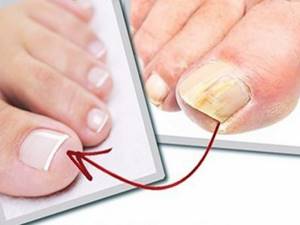
Most often, the following active ingredients are found in ointments and creams:
- miconazole
- amorolfine
- terbinafine
- bifonazole
They are produced under the brand names Lamisil, Miconazole, Bifosin.
Traditional treatment for nail fungus
Traditional medicine fights the fungus as best it can. The most bizarre means are used for this:
- rubbing kombucha pieces
- ointment of copper sulfate and goose fat
- chatter made of glycerin and tar
- lotions with vinegar and chicken protein
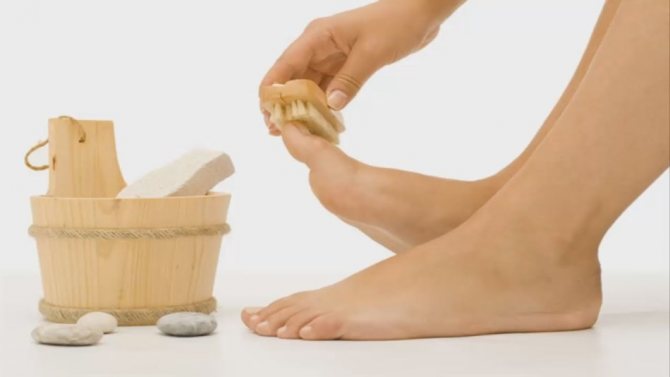
Many remedies have no basis. The most they can do is disinfection. If you carefully monitor cleanliness, the external manifestations of mycosis may indeed decrease for some time. But it is impossible to eliminate the cause without drug treatment.
So, mycosis is a complex and delicate disease. But don’t be shy, hoping that the fungus will go away on its own. If you notice manifestations of the disease, consult a doctor immediately. Then the treatment will be faster and easier, and the medications will be less toxic.
Treatment of nail fungus with ozone
Another unconventional method of treating nail fungus is ozone. The tissue around the affected nail is pricked with small injections of this substance. It is believed that due to this it is possible to suppress the activity of the fungus and restore the nail plate. True, official medicine is confident that it is impossible to restore the affected nail.

Ozone treatment is a method that official medicine is skeptical about
There are no reviews yet about getting rid of fungus using this method. And the doctors themselves, who recommend ozone treatment, admit that it needs to be combined with traditional medications.
Commonly accepted classifications
Pathology can be unilateral or bilateral. In the latter case, the nail grows in from both edges and quickly becomes deformed. But more often a unilateral lesion is diagnosed due to uncomfortable shoes, poor-quality pedicure, or “bunions” on the foot. To quickly decide on therapeutic tactics, doctors use two common classifications, which are based on the stages and location of onychocryptosis.
Stages
- Easy. The nail has just begun to grow in, so it has not changed in appearance. The disease manifests itself as moderate swelling and redness of the nail folds. Excess fluid has already accumulated in them, but there are no purulent impurities in it yet.
- Moderate. The tip of the finger has increased in size due to the formation of pronounced swelling and is hot to the touch. And the nail became visually narrower as a result of the formation of a small amount of excess soft tissue. It lost its shine, transparency, and became denser.
- Heavy. The plate was severely damaged - it became thinner, deformed, and covered with barely noticeable cracks. A lot of soft tissue has grown around it, and the periungual fold is swollen and red.
Localization
- feet. 10% of women and men who visit surgical departments every year are people with an ingrown toenail. The prevalence of this type of onychocryptosis is explained by the high load on the phalanges of this finger when walking. He primarily suffers from tight high-heeled shoes and from the manipulations of an unscrupulous pedicurist;
- brushes The plates on the hands are of the same thickness, so any of them can grow. True, this happens very rarely and is usually due to a metabolic disorder, congenital or acquired anomaly.
Nail problems: which doctor should a woman see?
If a nail disease occurs, first of all, you need to make an appointment and visit a dermatologist. This specialist will not only be able to advise you on all issues of interest, but also, based on the results of the examination and tests, will prescribe an examination with specialists of a more specialized profile, for example, a podologist or mycologist. In addition, if the patient has an ingrown toenail problem, then the dermatologist will write him a referral to a surgeon. Later in this article we will talk about each of the above specialists in more detail.
Mycologist
At its core, a mycologist is a specialist who treats fungal diseases of the skin and nails. Thus, if you have a fungal disease on your nails, and you are looking on the Internet for “a doctor who deals with problems of fingernails and toenails,” you should not waste your precious time so that the disease does not become chronic. Just make an appointment with a dermatologist, who will write you a subsequent referral to a mycologist. It is worth saying that you should contact a mycologist if you have:
- redness or rashes on the skin;
- itching or burning sensations;
- unpleasant odors or other signs of infectious or fungal diseases.
The diseases treated by this specialist include:
- lichen;
- candidiasis;
- dermatoses;
- fungal pneumonia;
- paronychia;
- aspergillosis;
- mucormycosis;
- panniculitis;
- onychomycosis;
- actinomycosis.
This medical professional also deals with various fungal nail diseases.
Causes and provoking factors
It would seem, what could genetics and an ingrown toenail have in common? But doctors have long established a connection. Onychocryptosis is much more common among those who have inherited excessive development of the fat pad surrounding the nail phalanges. The likelihood of ingrown nails is also higher in people with genetically determined metabolic disorders and endocrine diseases.
What else can provoke pathology:
- anatomical features - U-shaped thumbnail, C-shaped with a strongly beveled edge, flattened plate with an elevation of the periungual ridge above its surface;
- congenital or acquired foot abnormalities . The chances of developing onychocryptosis are greater with flat feet, uneven development of the foot muscles, and hallux valgus. Any of these pathologies sooner or later leads to inadequate redistribution of loads with impaired nail growth;
- wrong choice of shoes . It is women who often sin, preferring fashionable dress shoes with pointed toes, high heels, tight, and uncomfortable to wear. It is not surprising that after a couple of months not only does the nail grow in, but also a painful “bone” forms;
- increased load on the feet . You don’t need to stand on your feet for a long time or carry heavy loads to soon feel sharp pain in the big toe area. The load on the foot will also increase with a sedentary lifestyle if it causes a slow but steady increase in weight;
- foot diseases . When a fungal infection occurs, the nails first become thinner, then crumble and lag behind the bed. Sometimes they begin to grow again, but deviate to the sides, damaging the periungual ridges. Gradual ingrowth is also observed with hyperhidrosis - increased sweating. The tissue of the roller softens and the nail moves to the side;
- surgical removal of the nail . The operation is in demand for advanced fungus, subungual panaritium, and other diseases. After it, the nail is restored, but during growth it digs into the roller.
And most importantly, unprofessional pedicure is considered almost the leader among the causes of onychocryptosis.
Please note that the risk of triggering its development is high with careless processing of the cuticle, the free edge of the nail on the thumb, cutting it too low, or excessive rounding of the free corner. When performing a pedicure, leave at least 1 mm of regrown free edge and make the cut line straight.
Symptoms
Pain is the main symptom of ingrown toenails and the main complaint of patients when visiting a doctor. It does not appear immediately. At first, a person is bothered only by mild discomfort, which he attributes to being on his feet for a long time and simple fatigue. But as the inflammatory process develops, the severity of the signs of onychocryptosis increases. The problem becomes so obvious that it is impossible to ignore it.
Symptoms of ingrown toenails:
- the nail plate is deformed due to pathological growth of soft tissues and the formation of growths;
- the periungual fold becomes red, inflamed, and with severe ingrowth, ulcerates;
- the pain becomes constant: aching, pulling - at rest, tugging, throbbing - when moving;
- the local temperature rises - the reddened areas of the finger are hot, and the skin above them is dry, flaky;
- the upper phalanx of the damaged finger is noticeably larger than the neighboring ones, sometimes by 30% or more.
Keep in mind that in the absence of medical intervention or self-medication, the purulent-inflammatory process will not keep you waiting. Pathogenic bacteria will penetrate into wounds, abrasions, microcracks, and ulcers. As they grow and multiply, pus accumulates in the periungual fold, breaking out from time to time. If the abscess is not opened, the inflammation will spread first to the finger and then to the hand or foot.
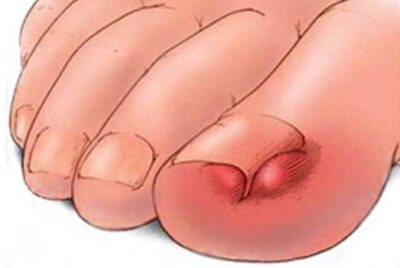
Note: sometimes onychocryptosis takes a chronic course. During remission, symptoms are mild and disappear when lying down or sitting. But as soon as a person puts on tight shoes, takes a long walk, and even becomes hypothermic, a sharp pain pierces the finger again.
When is a dermatologist needed?
Yellowing of your nails may be due to the fact that you smoke too much or often use dark polishes that color the nail plate yellowish. If you are not a heavy smoker and do not paint your nails, yellowness may indicate a fungal disease. Thickening of the nails, their grayish color, crumbling, and the edge of the nail lagging behind the bed also speak in its favor. Fungal infections are treated only under the supervision of a dermatologist and after mandatory laboratory tests.
Thickening of the nail and changes in its shape are often observed in diseases such as eczema, psoriasis, and chronic dermatitis caused by various reasons. Treatment of these diseases is also the responsibility of a dermatologist.

